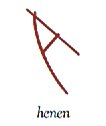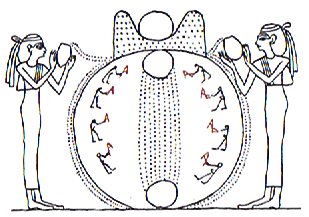2. As an emblem of power the 'stick' must have a history far older than man. The α male dominates the group not only among primates but also among other 'higher' animals (wolfs, lions and so on). The first letter, aleph, is a picture of The Bull. Prehistoric man used a spear to overcome even the most formidable of beasts. With agriculture another kind of stick became the digging tool. The bull sign is alluded to in the Egyptian hieroglyph for mattock:
Furthermore, the word 'mattock' seems to be related to the words 'bullock' and 'ballock'. Wilkinson mentions that the religious digging of the earth appears to be very old. In the Pyramid texts it is said, in connection with offerings to the deceased king: The mattock has picked the soil, offers have been carried forth ... O Geb (the god of earth), open your mouth for your son Osiris. The following picture (in Wilkinson) from a tomb is illuminating:
The goddess at left is younger (not so tall as the one at right, and the vessel she is holding is not so big as the one in the hands of the goddess at right). 4 + 4 males are holding henen [is it only coincidence that this word resembles henua?] signs and these men are also larger at right (and growing from top to bottom). 5 + 4 lines of dots connect the hole at the top with the hole at the bottom, and possibly the sun is depicted as going down at the very top outside the central circular form. I tried to count the dots in these 9 lines - guessing they might mean nights or something of the sort - and this is the result:
These numbers do not seem to be arbitrary. 128 (= 28 + 100) apparently serves to indicate the primary season, the season of growth. If the 9 dotted lines indicate the 'back side' of the year, then it will be 128 + 106 = 234 days long. 230 (the front side according to G) + 234 = 464. The dots surrounding the sun sinking low at the top appear to be 80 in number, and this would result in a satisfying 128 + 106 + 80 = 314 (= 464 -150). If the year gives 10 times 30 days to the sun, then half 300 should account for the 'front side'. If so, the total length of a year would be 150 + 314 = 464 = 16 * 29 days (or rather 8 * 58 because there are 8 men digging). Another way to count the total length of the year could be to add the dots formed by the fluids from the goddesses' vessels. |
||||||||||||||||||||||||||||||

